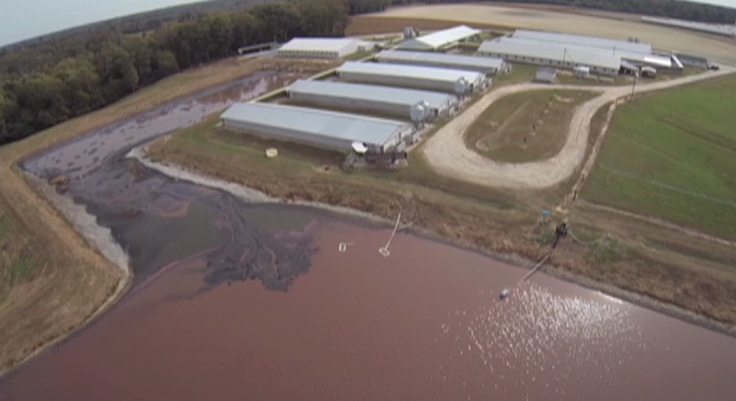Spy Drones Over North Carolina Factory Farms Reveal ‘Lagoons Of Filth,’ Filmmaker Says

Something stinks in North Carolina, and we’re not talking about the Charlotte Hornets. A documentary filmmaker who flew spy drones over North Carolina pig farms claims to have captured video footage showing oceans of untreated animal waste. The unappetizing aerial footage, some of which was posted on YouTube Wednesday, features sprawling panoramic shots of dark brown lagoons oozing into the green Carolina countryside, in some cases close to residential areas, the filmmaker said.
Mark Devries, a documentarian who took on factory farming in the 2013 film “Speciesism: The Movie," shot the drone footage as part of a two-year investigation into the public-health consequences of waste management on farms operated by Smithfield Foods Inc. -- the largest pork producer in the country. In a phone interview Wednesday, Devries said he first became aware of the “toxic cesspools” after speaking with neighbors who live near Smithfield facilities in Eastern North Carolina.
“I was shocked,” Devries said. “Pig manure is fairly similar to human waste, so it would be similar to having a pit of untreated human sewage the size of several football fields out in the open -- and in many cases, right in the vicinity of people’s homes.”
Kathleen Kirkham, a spokeswoman for Smithfield Foods, said the company stands by its environmental track record and noted that permits and records for its facilities are publicly available. She said state and federal regulators “sign off” on the company’s treatment systems, and Smithfield facilities are subject to regular visits from inspectors.
“On our farms we strive to be good neighbors and respect the rights and property of those who live near our operations,” Kirkham said in an email. “We work closely with all of our farmers to meet strict environmental management policies that encourage continuous improvement and exceed most state and federal compliance standards.”
The meat-packing giant is no stranger to criticism from environmentalists and animal-rights groups, and its “sea of waste” once earned it one of the largest fines ever from the Environmental Protection Agency, Rolling Stone reported in 2006.
Devries said his aerial footage offers a more detailed look at the company’s facilities than has previously been seen by the public. To capture the footage, he used a Hexakopter XL, a heavy-lifting drone built to carry camera equipment across long distances. The drone was equipped with a GPS and software to help stabilize it against heavy winds. Other consumer-model drones were used as well. He said the aerial vehicles were necessary to capture parts of the facilities that are obscured by trees and barbed wire.
Devries said Smithfield management wasn't aware of his investigation.
The project is likely to further spur the debate over “ag-gag” laws, which make it illegal to conduct undercover investigations at agricultural facilities. A number of states have enacted ag-gag legislation in response to animal-rights groups that capture footage of alleged wrongdoings at factory farms.
In North Carolina, an ag-gag bill failed to pass the state legislature earlier this year, meaning Devries is in the clear on that front.
Although ag-gag is often framed as an animal-rights issue, such laws also meet with fierce opposition and legal challenges from free-speech advocates. “The issue that it brings up is a much broader issue of laws criminalizing information gathering by the press,” Devries said. “It’s a pretty remarkable phenomenon if you think about laws being passed by state legislators for the purpose of preventing people from exposing the wrongdoing of these industries.”
Devries isn’t the only person using drones to capture footage of factory farms. Will Potter, a Washington-based journalist and one of the plaintiffs challenging ag-gag legislation in Idaho, raised more than $75,000 on Kickstarter earlier this year for his project, “Drone on the Farm: An Aerial Expose.”
Devries said he hopes his footage spurs more public discussion about “the environmental consequences and public-health consequences of these massive open pits of toxic waste.”
Watch the full YouTube clip below.
Christopher Zara is a senior writer who covers media and culture. Got a news tip? Email me here. Follow me on Twitter @christopherzara.
© Copyright IBTimes 2024. All rights reserved.












